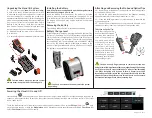
30
If SONO-WZ shows too high water contents in special concretes, the
G-Set
can be reduced by the corresponding
number of liters. The exact positive or negative value to be set as
G-Set
can be determined in two ways:
•
By comparative measurements with several correct target water contents of the concrete. E.g. with concrete
mixtures that were mixed with dry aggregates.
•
By comparative measurements with several correct determinations of the water content by kiln drying.
6.3 Using “kiln drying” as a refernce measurement
Correct kiln drying is expert work. A kiln moisture measurement result by weighing of a sample would be falsified
if free water would be bonded in cement due to a too long kiln drying time. Therefore kiln drying of fresh concrete
must be performed very quickly, in order to prevent that free water in the mixture can be bonded to the cement.
Please be aware of potential sources of errors when kiln-drying:
1. With the same fresh concrete sample, deviations in ranges of +-3 to +-10 liters/m
3
are not unusual when drying
with gas ovens or microwave ovens.
a. By use of gas oven kilns, care must be taken that no amounts of solids are blown away in the air during drying,
this would result in a too high moisture value. Fresh concrete samples may be stired during drying, or may
not. Depending what method used, different results may be determined. Not-stiring bears the danger that
the water will be bonded chemically inside the cement, due to a long drying time. This bonded water will
even at high temperatures not evaporate.
b. By drying with microwave ovens the drying time should be noted depending on the electrical power of
the microwave oven as both parameters influence the evaporation. As the overall amount of concrete
used with this method is comparatively small, it is important to use exact the same weights in consecutive
measurements.
2. When taking concrete samples for kiln drying, considerable deviations may occur. There is the danger of
segregation effects if the concrete was left in the bucket for a while. When taking samples of very liquid
concretes at the bucket surface, the dried sample could have a considerably too high water content.
3. When weighing very hot dried samples, the weighing result may be influenced considerably due to lift forces
of vertical hot air streams. When weighing a 4kg weight, dependent on weighing cell, the difference may be up
to 30 grams forced by the hot air stream. 30 grams at 4kg weight corresponds to a moisture error of 0.75%. In
worst case, these 0.75% moisture correspond to an error of +17 liter water per cubic meter.
4. Taking representative samples is very important: For example a 32mm gravel represents a water content of
5.3 Liter/m
3
when a small sample quantity of 1,5kg for microwave oven drying is used. With a higher sample
quantity of 5kg for gas oven drying, this gravel still represents a water content of 1.5 Liter/m
3
. In any way, and
especially dependent on the used drying method, one gravel more or less can lead to significant errors.
To minimize the influence of potential errors for
comparative measurements, we recommend to be
aware of the above mentioned sources of error and to
make use of the form “Construction Site Test” in the
Annex.
A higher accuracy can be achieved, when a reference
concrete is mixed by using absolute dry sand and dry
gravel with and a precise addition of mixing water.
Nevertheless care must be taken, as a long mixing time
of small samples may also lead to an escape of water.
For example, one minute mixing time of a small sample
can lead to an error (loss) of up to -5 liter water/m
3
.
Содержание SONO-DIS
Страница 1: ...Manual More information www imko de SONO DIS with SONO WZ and SONO M1 Moisture Sensor Experts...
Страница 12: ...12 SONO DIS with SONO WZ SONO WZ Robust mobile moisture probe for measuring water content in fresh concrete...
Страница 36: ...36 SONO DIS with SONO M1 SONO M1 Mobile moisture probe for sand gravel crushed stone and expanded clay...
Страница 58: ...58 7 Notizen...
Страница 59: ...59...
















































